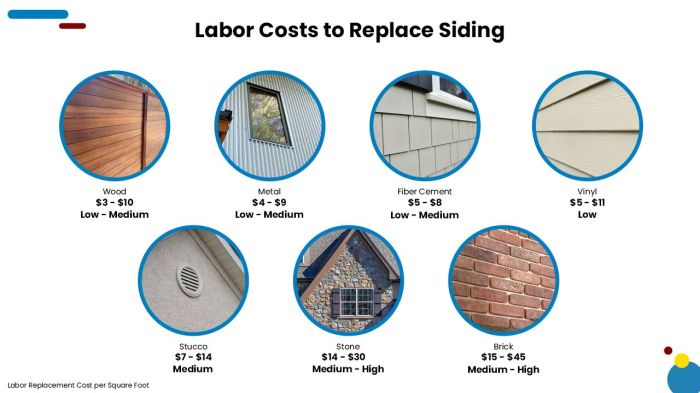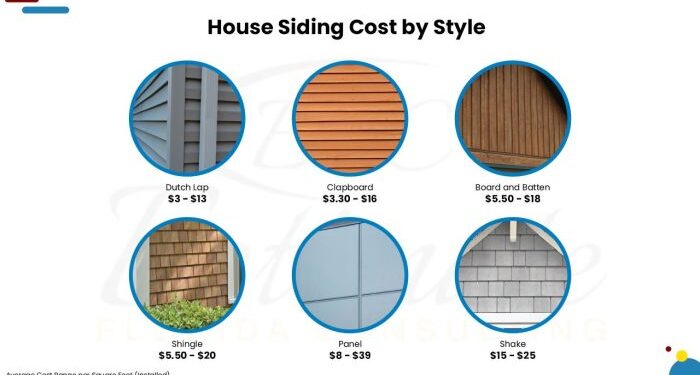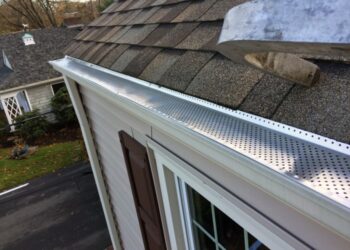Embark on a journey through the realm of cost per square to install siding, where we unravel the complexities and nuances of this crucial aspect of home improvement. From exploring different siding materials to understanding installation methods and cost-saving tips, this guide is your go-to resource for all things related to siding costs.
Factors influencing cost per square to install siding
When considering the cost per square to install siding, various factors come into play that can affect the overall price. Let’s explore some of the key influences on the cost of siding installation.
Types of Siding Materials and Costs
Different types of siding materials come with varying costs, which can significantly impact the overall price of installation. For example, vinyl siding is a more affordable option compared to fiber cement or wood siding. The material chosen will play a crucial role in determining the cost per square for siding installation.
Size and Layout of Property
The size and layout of a property also play a significant role in determining the cost of siding installation. Larger properties will require more materials and labor, leading to higher overall costs. Additionally, complex layouts or architectural features can increase the complexity of the installation process, impacting the final price.
Labor Costs, Location, and Additional Services
Labor costs, location, and additional services can also influence the cost per square for siding installation. Labor costs can vary depending on the expertise of the contractors and the region where the property is located. Additionally, additional services such as removing old siding, insulation installation, or trim work can add to the overall cost of the project.
Comparing siding material costs

When it comes to siding materials, the cost can vary significantly depending on the type of material used. Let’s break down the cost differences between popular siding materials such as vinyl, wood, fiber cement, and metal.
Vinyl Siding
Vinyl siding is one of the most affordable options available, making it a popular choice for many homeowners. The initial cost of vinyl siding is relatively low compared to other materials, which can make it an attractive option for those on a budget.
Additionally, vinyl siding requires minimal maintenance, which can help save on long-term costs.
Wood Siding
Wood siding tends to be more expensive upfront compared to vinyl siding. However, wood siding offers a classic and natural look that many homeowners find appealing. The maintenance requirements for wood siding are higher, as it needs to be treated regularly to prevent rot and decay.
This additional maintenance can increase long-term costs.
Fiber Cement Siding
Fiber cement siding falls in the mid-range in terms of cost. While it is more expensive than vinyl siding, it is generally less expensive than wood siding. Fiber cement siding is known for its durability and low maintenance requirements, which can help offset the initial cost over time.
Metal Siding
Metal siding can vary in cost depending on the type of metal used, such as aluminum or steel. While metal siding can be more expensive upfront, it is extremely durable and requires minimal maintenance. This durability can result in lower long-term costs compared to other siding materials.Each siding material comes with its own cost considerations, durability, and maintenance requirements.
It’s important to weigh the initial cost of materials against the long-term maintenance and replacement expenses to determine the best option for your home.
Installation methods and their impact on costs

When it comes to installing siding, the method used can significantly impact the total cost of the project. Factors such as the type of installation, insulation, and additional features all play a role in determining the overall expense.
Types of Installation
- Horizontal Lap: This traditional method involves placing siding panels horizontally, overlapping each other. It is a common technique that is relatively straightforward, resulting in lower labor costs compared to other methods.
- Vertical Panel: Vertical panel installation requires more precision and attention to detail, potentially increasing labor costs. However, this method can provide a unique aesthetic appeal to the property.
- Shingle Installation: Installing siding in a shingle pattern can be more labor-intensive and time-consuming, leading to higher installation costs. The intricate design of shingles requires careful handling and placement.
Importance of Insulation and Vapor Barriers
Proper insulation and vapor barriers are essential components of a siding installation project. They help regulate temperature, improve energy efficiency, and protect the structure from moisture damage. While investing in high-quality insulation and vapor barriers can increase upfront costs, they can result in long-term savings by reducing energy bills and preventing potential repairs due to moisture-related issues.
Additional Features Impacting Costs
- Trim Work: Adding trim around windows, doors, and corners can enhance the visual appeal of the siding but also incur additional costs for materials and labor.
- Soffits and Fascia: Soffits and fascia provide a finished look to the eaves of a structure. Including these features in the siding installation project can increase overall costs, but they contribute to the durability and aesthetics of the property.
Cost-saving tips for siding installation
When it comes to siding installation, there are several ways to save on costs without compromising the quality of the work. From considering a DIY approach to taking advantage of bulk discounts, here are some tips to help you get the most out of your budget.
DIY Siding Installation vs. Hiring Professionals
- Opting for a DIY siding installation can significantly reduce labor costs, as you won’t have to pay for professional services.
- However, it’s essential to weigh the pros and cons carefully, as improper installation can lead to costly repairs down the line.
Potential Savings from Bulk Material Purchases or Seasonal Discounts
- Buying siding materials in bulk can often result in discounts from suppliers, helping you save money on the overall project.
- Keep an eye out for seasonal promotions or clearance sales, as these can offer significant savings on materials.
Optimizing Siding Layout to Minimize Waste
- Planning the layout of your siding carefully can help minimize waste and reduce the amount of material needed for the project.
- Consider using standard panel sizes efficiently to avoid unnecessary cutting and waste during installation.
End of Discussion
In conclusion, navigating the realm of cost per square to install siding involves a careful balance of considerations ranging from material choices to installation methods. By arming yourself with the knowledge and insights shared in this guide, you’re better equipped to make informed decisions and embark on your siding installation journey with confidence.
Question Bank
How do different siding materials impact the cost per square?
The choice of siding materials such as vinyl, wood, fiber cement, and metal can significantly influence the overall cost per square for installation.
Is DIY siding installation cost-effective compared to hiring professionals?
While DIY installation may seem cost-effective initially, hiring professionals ensures quality workmanship and may result in long-term savings.
What factors should be considered to minimize siding installation costs?
Consider bulk material purchases, seasonal discounts, and optimizing the siding layout to reduce waste as effective cost-saving strategies.








